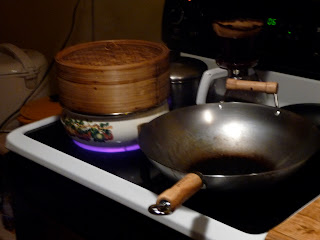Here is a recipe which includes shrimp, ground pork for people who want to enjoy tofu without being deprived of flavor.
Stuffed Tofu with Pork and Shrimp
 Ingredients:
Ingredients:2 boxes of firm tofu
1/2 cup raw shrimp, shelled and gutted, finely chopped
1 cup ground pork
1/2 teaspoon of salt
1 teaspoon rice wine
2 Tablespoon of cornstarch mixed with 4 tablespoon of water,
1 Tablespoon of dry cornstarch
2 Tablespoon soy sauce
1 teaspoon of sugar
1 cup water or chicken broth(more flavor)
3 Tablespoon oil
1 teaspoon sesame oil
a dash white pepper (optional)
cilantro, green onion for garnish (optional)
1. Put ground pork, shrimp, salt, rice wine, 1 teaspoon of cornstarch mix in a small bowl and blend well.
2. Cut tofu into triangles and scoop out the center, add to the pork/shrimp stuffing mix. Sprinkle a little dry cornstarch inside the tofu triangle. Stuff the triangles with shrimp mix and set aside.
3. Heat the oil until hot in a wok or frying pan. Dip the triangle's stuffed side in remaining corn starch mix(save one teaspoon) before browning, this prevents them from separating. Cook with medium heat until all sides are golden brown.
4. Add soy sauce, sugar, rice wine, water or broth and white pepper if using. Simmer for 10 minutes. Add cornstarch mix (1 teaspoon corn starch, 2 tablespoon water), cook until the sauce thickens.
5. Put on a plate, drizzle sesame oil, sprinkle cilantro, green onion and serve.
Notes: Tomatoes or shitaki mushroom will add interesting and extra flavors to this dish. Add one or the other (I wouldn't use both, then it is too much flavor and we have a name for it - Chop Suey!) at step 4.
S.P. asked another good question which might interest you as well: How do you make dishes flavorful but not spicy? - I used lots of garlic and onions (green onion for Chinese.) For Asian cooking, fermented black beans, dried shitaki mushrooms, sesame seeds and oil, Chinese rice wine, Cantonese oyster sauce, Japanese sweet wine Mirin and miso, Vietnamese fish sauce, Thai Tamarind, tomatoes, basil, lemon grass and chicken broth all enhance flavor without adding heat. Another aspect of Asian cooking I think need to be addressed is the balance between saltiness and sweetness, Asian American restaurants tend to be "crowd-pleasers" leaning too much towards the sweetness.
I'm excited that a neighbor is going to teach me how to make tofu from scratch. You might wonder why a Chinese need to lear how to make tofu from an American. Well, this is another assumption many people have - the reason I don't know how to make tofu is in Taiwan tofu is so available and inexpensive, and there are so many varieties, not just the white square in a box you see here, and they are freshly made daily. By the way, please don't ask me how to cook rice on the stove stop, I don't know because I always use a rice cooker! Happy Chinese New Year, everyone! (February 3rd, 2011)










